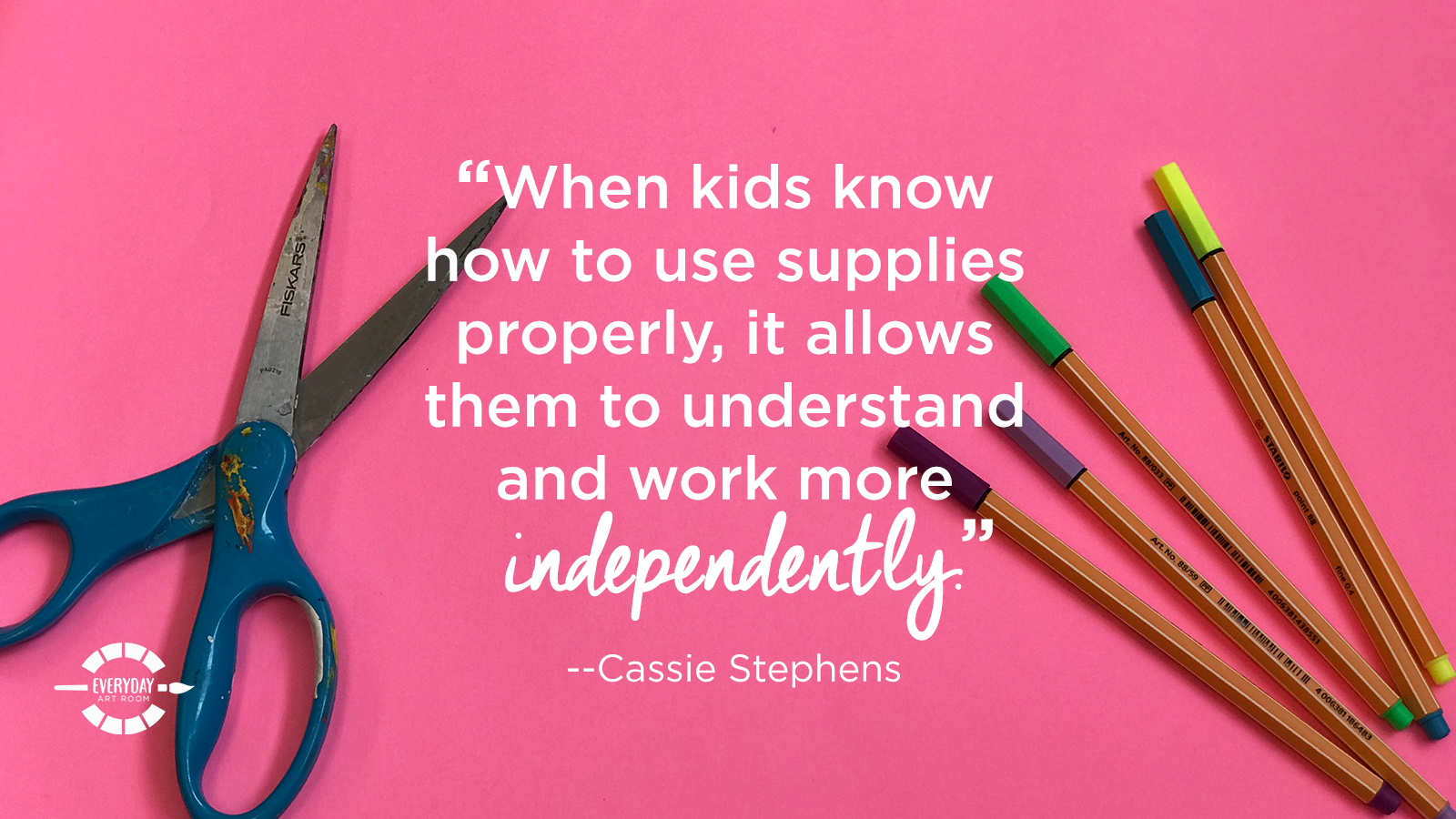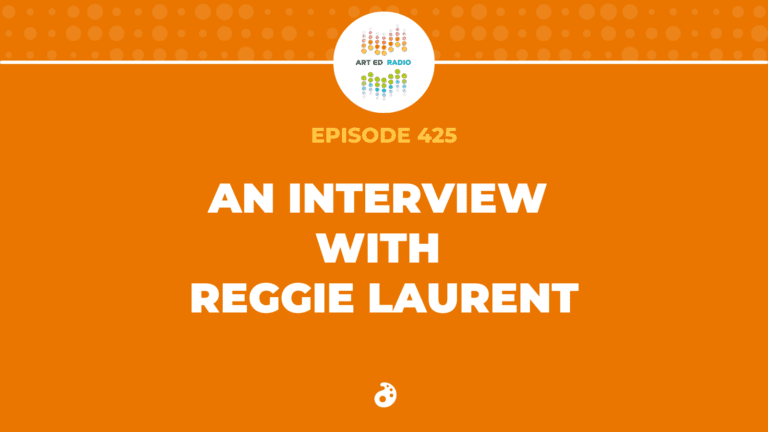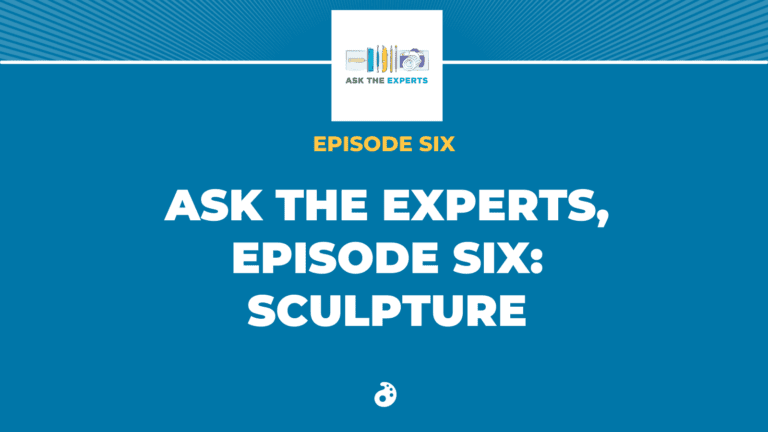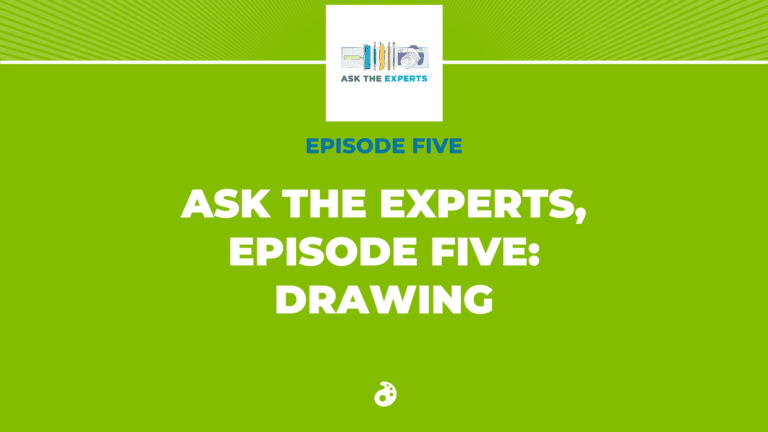How important is it for our kids to know the correct techniques and the right ways to utilize supplies? For Cassie, it’s vital. Listen as she talks about the benefits of students learning to use supplies correctly, how students’ knowledge of supplies can eliminate frustration, and how you can develop confidence in your kids when they learn the right tool for the right job. Full episode transcript below.
Links and Resources
- Promoting Independence with Students
- Another Way to Build Skills
- Oil Pastel Techniques
- Watercolor Techniques

Transcript
Cassie: The other day on social media land, I was sharing some paintings that my kindergarten students had just finished working on. They are creating large backgrounds on 12×18 pieces of white paper and they are using the cold colors and small pointed brushes, and they’re filling this sheet of paper with overlapping spirals. Some of their spirals are large, some of their spirals are small, and one thing that all of their spirals have in common is that they are painted with a fluid or a wet brush. We don’t have any scratchy spirals. We don’t have any scrubbed outlines on our papers. We have very beautiful fine lines and that’s not by accident. That’s because I taught them how to do that, and when I was sharing their paintings on social media, I got a lot of questions, not one question or two, but many from teachers saying, “How are you getting your students to paint like that? When my students paint, they dig into the watercolor paint, they gouge their papers with their paintbrushes, they sometimes put holes in their paper.”
Y’all, I totally get it because I’ve been there with my students and it got me really thinking that for the longest time I didn’t explain in great detail to my students how to correctly use supplies and materials for fear that I might somehow crush their creativity. I’m here to tell you that after years of teaching children how to be creative, that one key element is making sure that they are successful in using the supplies so that they can be successful when channeling their creativity. I wanted to go into depth with y’all about that topic today and really talk to you about how that looks in my art room and how you might also want to make that happen in yours. I’m Cassie Stephens and this is Everyday Art Room.
I want to start by sharing with you my three reasons why I believe it’s so important to teach our students how to properly use art supplies. My reason number one, top number one reason, is because it’s going to eliminate frustration. It will eliminate frustration on two fronts. It will eliminate frustration for you as a teacher and it will eliminate frustration for your students, the creatives in the room.
So let’s start with just traveling back in time to when I was a first-year teacher. I had spent I think about two weeks teaching my second-grade students a lesson on drawing themselves in our town, which is Nashville. So they were to create a self-portrait in the town of Nashville with local landmarks, just kind of exploring and enjoying our great city. We had spent a long time drawing them. We then traced them with a Sharpie and then we were going to color with crayons and markers. I remember I just kind of just threw the supplies on the table at them and thought well let’s just watch them go for it. They know how to color, right? Oh my goodness, you ain’t never seen an art teacher snatch up art supplies so fast.
As soon as I saw markers laying around without caps and crayons that were being scribbled scrabble colored every which way, I just about had a conniption. I was like, y’all don’t you know how to use markers and crayons? Of course, they said yes. They, of course, knew how to make a mark on a paper with a crayon and a marker, but did they know how to use those supplies in such a way that was going to make their artwork successful? I mean if you give a kid a marker, for some reason it’s like giving a kid a timer. They feel like they’ve got to color with that marker like speedy, so fast. What is it about a marker and a crayon, but usually markers, maybe because they go a little faster, I don’t know, but regardless I know that I was frustrated and they, of course, were frustrated because they’d spent so much time on their artwork just to see that be kind of demolished by this poor craftsmanship.
That’s when I learned pretty quickly that if you want your students to be successful, and to be able to use supplies successfully, you need to show them how to use them. Even something that you might consider basic, like a crayon or a marker. Trust me when I say it will eliminate frustration on your part. Let’s be honest, if you’re a happy art teacher, then you’re gonna make for a happy art room. A frustrated art teacher, where students are not using supplies correctly, makes for a pretty unhappy you and that usually resonates throughout the art room.
The second reason why I think it’s so important to teach our kids how to properly use art supplies is that it paves the way for their success. It gives them a boost of confidence. I’ve watched my students struggle to cut something out and be frustrated when it wasn’t cut out neatly or if they were cutting something out and they accidentally lopped off let’s say part of a body part when they were cutting out a little image of themselves, and they get frustrated by that and upset because they’ve just demolished their work of art.
When you show your students how to correctly cut something out, or let’s say when my kids are working with chalk, and they wanna make a beautiful color so sharing with them how to blend colors that are analogous and how to do that properly so you end up with a beautiful bold color, as opposed to mud because you just smeared your hand across all of the colors in the rainbow, then you’re going to make it so that they are much more confident in using those supplies.
The third reason is because when kids know how to use art supplies properly, then it allows them to understand the supplies and materials better and so that in the future when they’re working either independently on their own or you’re able to give them a variety of supplies to choose from, they’ll know which supply is best for the job. Which paintbrush is going to give them a thick bold line as opposed to a tiny line. Which brand or kind of paint is going to give them a translucent look versus an opaque look. Is chalk better or oil pastels better for the situation? If they know how to use all of those materials and supplies better, then they’re going to suddenly have this knowledge on which supplies are best for the job, for the job of what masterpiece they’re trying to create.
So eliminating that frustration, paving the way for the success and the confidence boost, and giving them that knowledge of the supplies and the materials, those are my three tops for why it’s vital to teach kids how to use supplies correctly. I think a lot of us know this already, but I also feel like sometimes, this happens to me, there’s that little voice in the back of your head that says, “Shouldn’t we just let them go for it? Shouldn’t we just let them explore with these materials and just see what happens? Am I harming their creativity by telling them how to do every single thing in my art room?” I’m just gonna flat out say no. For me, I tell that voice no. I’ll get more into detail on why in just a minute, but before I do, I wanna talk about my ways, my top five ways on how I teach my students how to use supplies correctly.
So I’ve preached about why it’s important, now I’m gonna try to give you a visual of what it looks like in my room. So first of all, you have to think about, well what art supplies and materials do I have to teach them about? Y’all, I’m here to tell you, you gotta teach them about every single thing, even something like a pencil, even kids as old as middle school. Assume nothing, that has been my experience. You don’t know how much they’re able to do in their classroom. I mean, when I first started teaching, kids were creating a lot more in their classrooms than they are now, just due to all the testing they have to do. When I started teaching, kids were creating a lot more at home, but that’s also changed due to technology. So I like to basically assume that my kids don’t know how to hold a pair of scissors. I’ve seen it, it’s kind of scary how they do and even holds a pencil correctly. How to draw lightly and not draw so hard, and how to correctly use even an eraser. So I assume nothing.
I’m gonna share with you some examples. That lesson I mentioned at the beginning of the podcast of my students painting spirals. When I’m introducing that lesson to my Kindergarten students, we’re using a kind of watercolor in a pan paint, not liquid watercolor. So I mention to them that they have to wake up all of the colors by adding a little drop of water to each color. I have noticed of course the sillier that I make it, the better. So when I add a little drop of water to the blue, I say “Wake up blue!”, and blue says, “I’m here Ms. Stephens.” “Wake up green!”, “I don’t wanna wake up.” That kind of thing, just to be silly, but it captures their attention and it makes it so when they go to their seats, they’ll remember what to do. It’s hilarious to hear them all trying to wake up their colors and the colors responses to them.
From there, I talk to them about their paintbrush, and this is the same routine we go through every time we paint. I know you’ve heard me say it before and I’ve shared lots of videos on this too, of me and my students doing this kind of call and response. My paintbrush is like a Balle-Rina, that’s them finishing it. She’s always on her tippy-Toes, or he. She never, or he, ever scoot around on her bottom, because nobody wants to go to the booty scooting ballet. We literally say that every time we paint. So it just becomes this funny thing to help them remember.
I also have a large paintbrush that I demonstrate that when we’re painting these spirals, we’re not going to hold our paintbrush like a pencil, so it won’t be diagonal. We’re going to hold it perfectly up and down, so it’s vertical. I also tell them to take their paintbrush, when they get to their seat, and hold it in their hand, and with their other hand have their paintbrush paint on their hand. Not with paint, but before painting. I should have made that more clear. Before painting, have your paintbrush tickle the palm of your hand and what this does is it allows them to see the difference in pressure that they are putting on their paintbrush to the paper. I tell them that it should feel like the paintbrush is tickling your hand. If it’s barely touching your hand and tickling your hand, that’s how it should feel when you’re holding your brush to your paper. If it’s pressing, and then I tell them to make sure when they get to their seat, to also then press it firmly on their hand. Do you notice the difference? It’s going to feel a lot rougher, the bristles are going to be spread out, your spirals are not going to turn out as beautifully as you might want them to.
When they go to their seats, I encourage the kids, “Remember before you paint, tickle the palm of your hand so you can see the kind of pressure you’re going to be using.” So that’s just one example. Oh, and let me back up, another thing, here’s what I know that you guys do this all the time too. As you’re watching your students work, take a mental note of all of the things that you see them doing “wrong”. For me, when my students are using pan watercolor paint, their biggest mistake is not using enough water. They are tempted to just kind of gouge that paintbrush into the paint and the end result is they make lines that are very scratchy on their paper. So another thing I share with them is this: “If your paintbrush is making a scratchy line, that’s your paintbrushes way of telling you that it’s thirsty and it needs more water. It doesn’t need more paint. It needs more water.”
So going over all of those steps, and I’m talking with my Kindergartners all the way up to my fourth graders, even though for them it might just be a reminder, I don’t even care if you’ve heard me say it 20 times before, I’m gonna say it again. Assuming, even though they’ve been with me for three years or four years, assuming that they still don’t remember how to use those supplies, I always repeat. I do the same thing with how to hold a pair of scissors. Your scissor holding hand. Y’all, I used to assume that kids knew that the little scissor hole was for their thumb and the bigger ones were for their couple of fingers. No. They don’t know this. Make sure you tell them, and I often remind them scissors are always pointing out, your not dominant hand does all the work of turning the paper. I’m not going to go in details on that, but if you want to see how I teach that, you can, of course, hop over to my YouTube channel. I’ve got lots of videos of me basically over explaining things, is what it’s going to seem like, but if you want your kids to be successful, that’s gonna be what it takes.
Even as simple as something like how to use an eraser. Have you seen kids try to erase something and then they just completely crinkle up their artwork, or even worse tear it? You need to show them, when you erase, spread your non-dominant hand out, hold that paper flat, and when you use your eraser, push your eraser in one direction, away from you. Only go in one direction. If you go back and forth, it brings the paper back with it and it can cause it to wrinkle. So just explaining all of those things is going to really make it so they’re successful.
My second tip is, like I said, if you see them struggling with anything, then you need to explain it to everyone, because it’s not just going to be one student who’s going to be making scratchy lines on their paper or accidentally wrinkling their paper, or using a glue bottle incorrectly. It’s going to be all of them. Even if there are kids who are using things correctly, it doesn’t ever hurt to remind them. Of course, having a funny little saying, “Draw light until you get it right”, “Booty-scootin’ ballet”, having your kids talk to their hands and have their hands talk back to them, this is just something goofy we always do. Any of those silly things, you guys know I’m a big, my big saying is silly sticks. If it’s silly, they’re going to remember it. So, silly is going to stick.
Sometimes teaching though isn’t enough. I learned that with my Kindergartners this week. I can explain things until I’m blue in the face, but sometimes when they go to their seats they need an extra hand. If I see a student struggling when they’re working at their seats, and this is for all of grades, the first thing I always do is walk around the room, no matter what grade level is working, I take a little loop around the room and I scoot in everybody’s chair. I don’t know what it is about my chairs, or if it’s just kids in general, but why they gotta sit 20 feet away from their desk and reach so far. I don’t mind, I have those kids who love to stand. If you want to stand, fabulous, just push your chair in so I don’t trip and fall to my death. But if you’re going to sit, then you have got to scoot your chair in. Now, my first graders and kindergartners, they cannot physically push their chair in. So I always do a quick loop around the room, I scoot in chairs, I always tell them to sit back, relax, enjoy the show as I scoot them up, which they think is hysterical, and I also then at that time take a moment to just double check, “Did you get your name on the back of your paper?”, and also are they using the supplies correctly.
I am not afraid of doing some hand over hand action if I see them not using their paintbrush or scissors correctly. So for example, this week I saw a student who just kept pressing so hard to make their spirals on their paper. Their brush was flattening out, it was making a scratchy line, and I could tell they were becoming frustrated. Each one of their spirals looked the same. They told me, “I’m trying. I can’t do it.” Well, of course in my room whenever anybody says, “I can’t”, all the other kids say, “Yes you can!” Which is really cute the first ten times until they all start saying I can’t on purpose and then you really regret your life choices, but regardless. What I did with the student as I said, “I’m gonna demonstrate on a piece of paper.”
So I demonstrated and they said, “I am doing that.” So they firmly believed that they were tickling their paper and holding it lightly, and they were doing exactly what I was doing. In their mind, they were following directions perfectly, but not getting the same result, and they were frustrated. So that’s when I took their hand in mine, showed them how to hold the brush vertically, and showed them how to very lightly tickle their paper, and as I was building that spiral and having it get bigger and bigger with them, I said, “Okay, I’m going to let go now.” When I let go, they understood to hold the paintbrush correctly and make the spiral light.
It’s kind of like when I was learning to ride my bike. My dad would hold my bicycle and hold it and guide it for me and then let go. You’re not harming your student by doing these things. You’re helping them. Think of it this way, because I know I might get a little bit of flack for saying this. I might get a little bit of flack for telling you to place your hand over your student’s hand and guide them. When I was taking piano lessons as a kid, my piano teacher would always take my wrists and lift them up and she would hold her hands over mine so that I would feel how to position my hand and how to lightly touch the keys and not press so hard. She would do that again, and again, and again until I got it right and I was able to hold my hands just like hers and have the same result, or as far as I believed, to her. I believe in doing that with our students. That’s what’s going to help them understand how to use supplies and be successful and confident, and you better believe that little dude was thrilled with his teeny tiny thin spirals that he had been trying so hard to achieve, but just couldn’t do it until I really showed him how to hold that brush.
The reason we do these things is to set our kids up for success. Another reason is once the kids know the “rules” of how to use supplies correctly, how to use chalk pastels and oil pastels and watercolors and all those amazing supplies we have in our room, once they know how to use them correctly, that’s when we can show them or let them explore how to break the rules. We don’t want them starting off breaking the rules. If they start off breaking the rules, all the supplies will pretty much become demolished and they’re not going to have the confidence when it comes to getting ready to break those rules. Showing your students rule breaker artists, the Jackson Pollack’s of the world, people who took those supplies and did something totally opposite of everything that they’ve just learned, is so much fun. That’s something I love to do with my fourth graders. When you show them how to splatter paint or you show them how to do something completely opposite of what you’ve often told them, but watch them explore those rule breaking things with success. That’s where the real magic and fun happens.
So, long winded talk, just like always. Show those kiddos how to use those supplies and definitely assume nothing. Trust me when I say it will make it so you won’t be frustrated on good days and neither will they.
Tim: Hello, this is Tim Bogantz from Art Ed Radio. I wanna tell you again this week about Art Ed PRO, the essential subscription for professional art teachers. It on-demand and professional development with video tutorials, downloadable handouts, and all kinds of other resources to help take your teaching to the next level. The library has nearly 90 learning packs in it, but we are going to keep adding to it. There are in fact three new learning packs that just came out over the weekend, Collaborating with Paraprofessionals, Drawing the Human Form, and Standards-Based Grading. It’s all great stuff. With so many topics already covered, and three new packs released on the first of every month, it is the PD you need when you need it. Make sure you check it out and start your free trial at theartofed.com/pro. Now let me turn it back over to Cassie as she opens up the mail bag and then finishes out the show.
Cassie: Now it’s time to take a little dip into the mail bag. This question wasn’t mailed to me directly, but I saw it on one of the Facebook art teacher groups, and I thought it was such a great question, there were so many fascinating responses that I wanted to share. The question is, “If you have a Master’s, what is it in and why? Just trying to plan my next five years and I don’t know which direction to go.”
All right, so first of all let me start by saying that I know that many of you live in states that require you to get a Master’s after so many years of teaching. I live in Tennessee, it is not a requirement for me to get my Master’s. I know so many people, my brother included, he’s an English teacher on a reservation in Arizona, and I know so many people feel pressured I guess or obligated to pursue getting a Master’s. Like I said, if it’s something you’ve gotta do because of your state, then obviously you’ve gotta do it, but if it’s not something that you have to do, but you feel like you should, maybe that’s something that you should really stop and think about before plugging your nose, shelling out the big bucks, and diving in.
Here’s why, when I first got out of college and I had my BFA in painting and my Ed degree, all of my painting buddies were jumping right to the next step of getting their Master’s in painting. I thought, “Man, I so wanna do that. I wanna do that.”, and my boyfriend at the time, who now happens to be my husband, said to me, “Why do you wanna spend all this money to get a painting degree? I mean why don’t you just like paint and stuff or take some classes and then get some advice that way? That’s a lot of money.” Then when I thought about pursuing, like for five minutes, pursuing my Master’s in art education, I realized how much I flipping hate writing papers. Oh my gosh, let me type on a blog all day long, but if you ask me to do a research paper, I will procrastinate the living daylights out of that bad boy and then probably start it at three a.m. and that’s not how I wanna live my life.
So, really think about if this is something that you want to do or something that you feel obligated to do. If it’s going to cost you X amount of dollars, what if that check was just given to you? What would you do with that money instead? Me, I would go travel and gather life experiences. Experiences that I don’t feel like I personally could get by taking classes. Now granted, I could probably meet a lot of great people by taking some Master’s classes, but could I also meet great people traveling? I mean that would be where my money would go. Maybe your money would go somewhere else. Maybe it would be to take a class, a sewing class, a needle-felting class, an anything that you’re interested in class, and also think about the time. That’s gonna be a lot of time to devote to something if you’re not 100% sure that you wanna do it.
I think a good idea would be to just start by just jotting down what’s your bucket list? What’s on your bucket list? In five years, what is something that you wanna say, “Yeah, I’m glad I did that.”, and if getting a Master’s is that, then yes pursue it, but what if it’s like, “I wanna write and illustrate a children’s book.”? “I want to be able to open my own Etsy shop and sell the ceramic pieces that I love to create in my spare time.” What if it’s that? If it is that, it’s gonna be hard, you’re gonna have a hard time pursuing those things if a lot of your time is devoted to something else.
Anyway, I thought it was a fabulous question. I know a lot of us have this idea and thought in our mind about furthering our education and it’s a great thing. I’m not knocking it. I’m just saying for me it would be something else I would pursue and just for you to make sure it’s something you’d wanna do too. If you have a question for me then you should totally send it my way. You can find me at EverydayArtRoom@theartofed.com.
So you know those like smelly markers that Mr. Sketch makes? Yeah. So those you’re definitely gonna wanna talk to your kids about how to use those correctly and how not to, I don’t know, stick them up your nose because they smell so stinking good, or put marker dots all over the top of your nose so that they smell stays with you throughout the day or make sure you let your kids know that those markers, while they smell divine, they don’t taste it. I’ll never forget when I saw a kindergartner with a string, a string of red saliva, slowly oozing out of his mouth, while he was holding the red cherry smelling marker. I said, “Did you stick the marker in your mouth?” They shook their head no. I said, “Let me see the tongue.” It was bright red y’all. Cherry red. I said, “Now we know that these markers, they smell nice, they don’t taste nice. Did we learn that today?” I got a nod. “Please go get a drink of water.” Yeah. Just when you think you don’t have to explain it, you need to explain it.
Thanks, guys for letting me share and I hope y’all have the best week ever, without any marker eaters. Toodles.
Magazine articles and podcasts are opinions of professional education contributors and do not necessarily represent the position of the Art of Education University (AOEU) or its academic offerings. Contributors use terms in the way they are most often talked about in the scope of their educational experiences.



